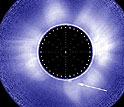|

Press Release 05-084
Magnetic Structure on Sun Is Responsible for Powerful Solar Storms

Finding may help scientists better predict storms' effects on Earth
May 26, 2005
New research links a particular magnetic structure on the Sun with the genesis of powerful solar storms that can buffet Earth's atmosphere. The research may enable scientists to create more accurate computer models of the solar storms, known as coronal mass ejections (CMEs), and could eventually point the way to forecasting the storms days before they occur.
"This discovery represents a potential breakthrough in our ability to forecast space weather," says Rich Behnke, section head in the National Science Foundation (NSF)'s division of atmospheric sciences, which funded the research. "Until now, all we could do was predict the impact of these massive storms after they had erupted. Now we hope to have forecasts telling us that these eruptions soon will be occurring."
Sarah Gibson, a scientist at the National Center for Atmospheric Research (NCAR)'s High Altitude Observatory (HAO), will present her findings at the American Geophysical Union conference in New Orleans on Thursday, May 26.
CMEs are a focus of solar research because they suddenly and violently release billions of tons of matter and charged particles that escape from the Sun and speed through space. Those ejections that are pointed toward Earth can set off disturbances when they reach the upper atmosphere, affecting satellites, ground-based communications systems and power grids.
For her research, Gibson turned to a unique dataset: white-light images of the lower reaches of the Sun's enormous halo, called the corona. Taken by HAO's Mark-IV K-Coronameter on Mauna Loa in Hawaii, the images are sensitive to density alone, avoiding the ambiguity of most other solar images that depend on both temperature and density. The images revealed that lower-density regions in the corona that appear to be twisted magnetic field lines can form prior to a CME. The twisted areas, known as magnetic flux ropes, store massive amounts of energy."
"The structures indicate the presence of a magnetic system that has enough energy to fuel a CME," Gibson explains. "But that isn't, by itself, an indication that a CME is about to occur. For that, we need to look at additional characteristics."
Gibson and her coworkers used coronameter images to observe dark, lower-density areas, known as cavities, that can be formed by magnetic flux ropes. Gibson's next steps will be to analyze cavities that result in CMEs to determine whether they have identifiable characteristics that may help scientists forecast a CME. Her preliminary findings indicate that a cavity begins to bulge and rise higher in the corona just before erupting. Cavities may also darken and become more sharply defined prior to eruption.
The research may put to rest an important debate among solar physicists over whether magnetic flux ropes can form prior to an ejection or are present only when an ejection takes place. Gibson's findings suggest that, to understand the forces that create CMEs, solar scientists should use magnetic flux ropes as the starting point of computer models of these massive storms.
-NSF-

Media Contacts
Cheryl L. Dybas, NSF (703) 292-7734 cdybas@nsf.gov
Anatta , NCAR (303) 497-8604 anatta@ucar.edu

The National Science Foundation (NSF) is an independent federal agency that supports fundamental research and education across all fields of science and engineering. In fiscal year (FY) 2009, its budget is $9.5 billion, which includes $3.0 billion provided through the American Recovery and Reinvestment Act. NSF funds reach all 50 states through grants to over 1,900 universities and institutions. Each year, NSF receives about 44,400 competitive requests for funding, and makes over 11,500 new funding awards. NSF also awards over $400 million in professional and service contracts yearly.
 Get News Updates by Email Get News Updates by Email
Useful NSF Web Sites:
NSF Home Page: http://www.nsf.gov
NSF News: http://www.nsf.gov/news/
For the News Media: http://www.nsf.gov/news/newsroom.jsp
Science and Engineering Statistics: http://www.nsf.gov/statistics/
Awards Searches: http://www.nsf.gov/awardsearch/
| 


